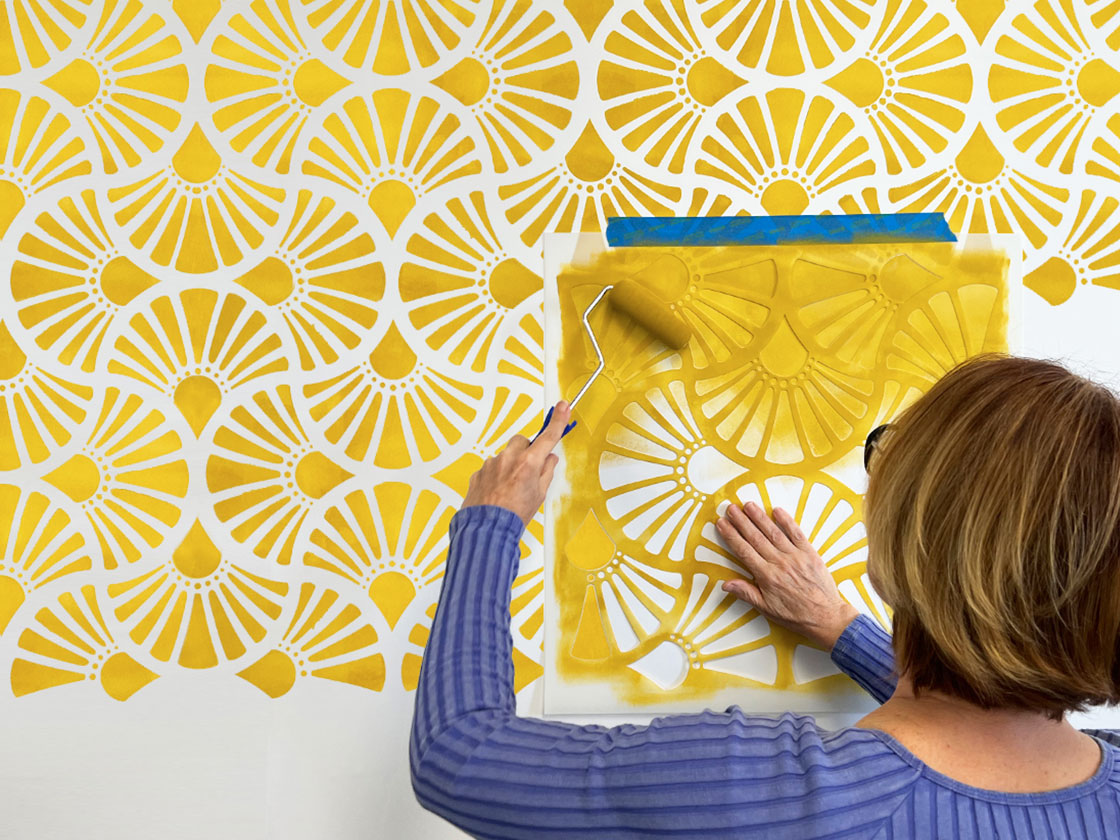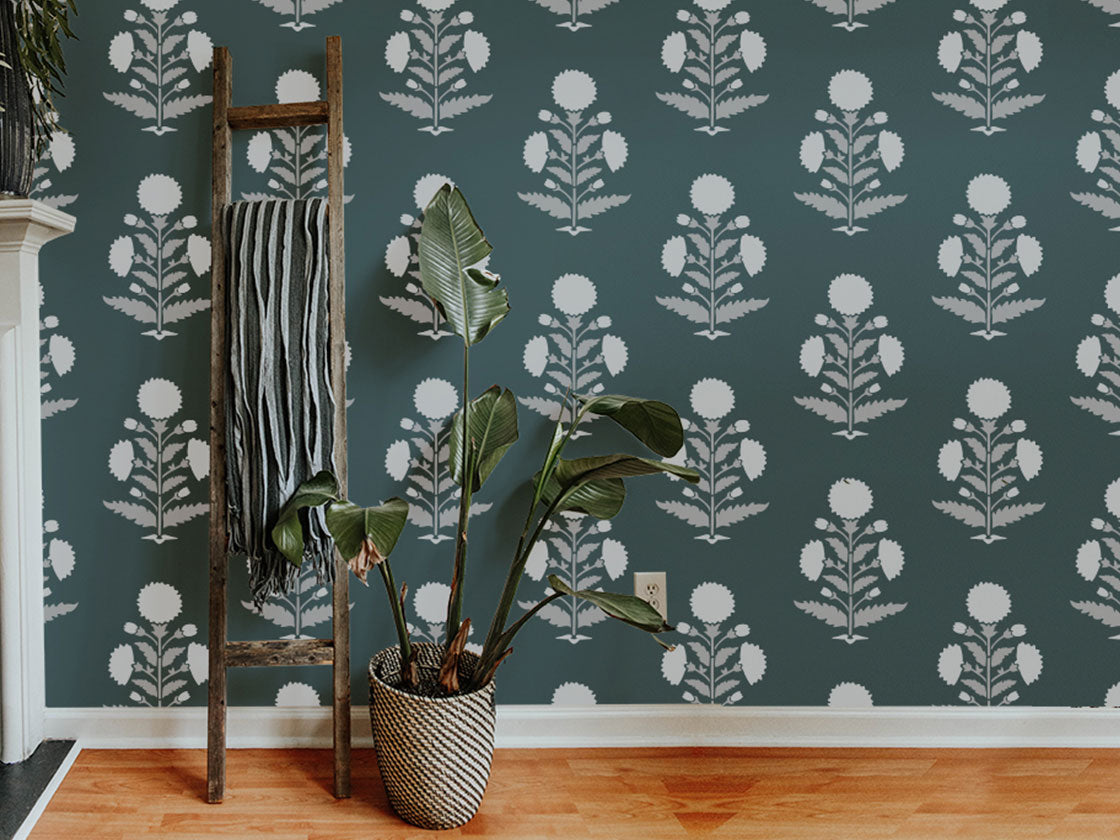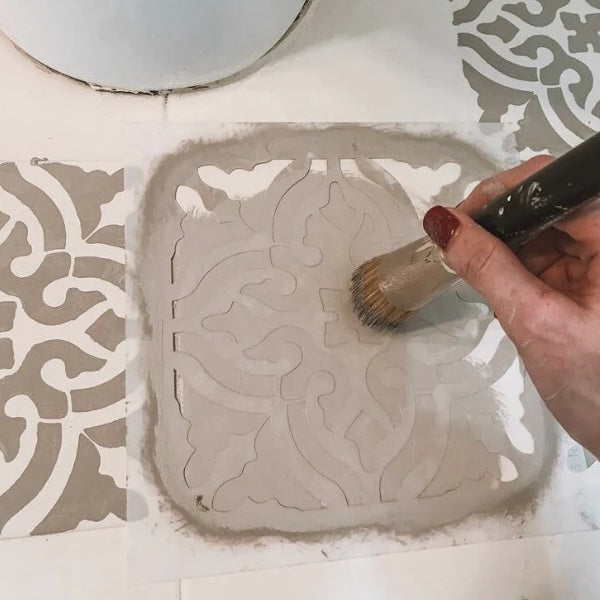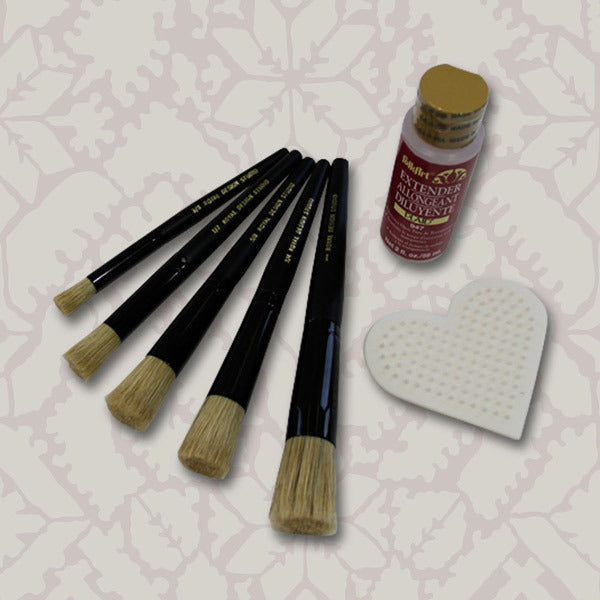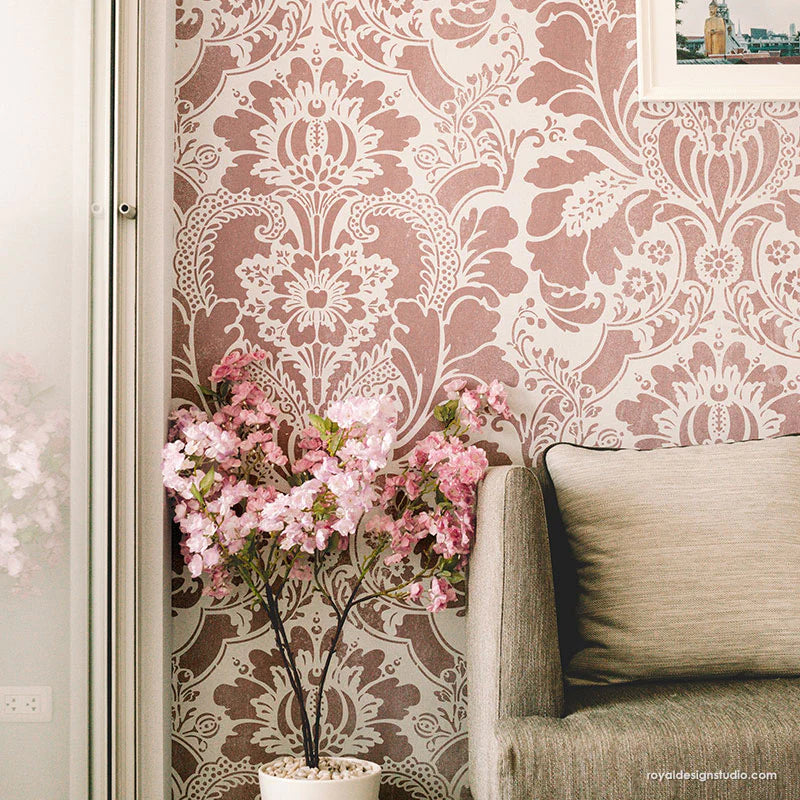Product Questions
Our stencils are laser cut from industry standard clear mylar plastic. The vast majority of our stencil designs are cut from thicker 10mil mylar. A few of our larger designs need to be cut from 7mil mylar
Mylar is very durable, meaning that you can use your stencils successfully and indefinitely as long as you clean and store them properly (loosely rolled). We sell a stencil cleaning product that makes cleaning stencils easy, Motsenbockers Lift-Off 5.
See How to Clean Stencils and Brushes for more details on proper stencil cleaning.
Both Stencil Brushes and dense foam Stencil Paint Rollers make great options for both beginning and experienced stencilers. Both options are available to purchase along with your stencil order in our Stencil Supplies area. Like any other art or craft, the more practice and experience you have stencil brushes and rollers the easier it becomes.
Stencil Brush Pros
Our Stencil Brushes come in many different sizes. You can choose the best size for your project. Using smaller brushes allows you to control the application of paint to smaller areas. This is especially handy when you are trying to color different pattern areas with contrasting colors. Use larger stencil brushes when just stenciling in one color. Ours come up to 3” wide, and allow you to stencil large stencil patterns quickly
Stencil Brushes give you better control over the application of paint and the amount of pressure you use. This leads to cleaner edges with less opportunity for paint to bleed under the stencil-and less touch-ups at the end of your stencil project!
*As always with stenciling, it’s important to off-load excess paint on to paper towels each time you reload the brush.
Stencil Brush Cons
Stencil Brushes can’t cover the same amount of area as quickly as a paint roller, so ultimately it can take longer to complete a stencil project with a smaller brush. However, we have developed our own Super Large 3” Stencil Brush that holds a lot of paint and works very quickly for larger stencil patterns.
Stencil Paint Roller Pros
Stencil Paint Rollers are ideal for projects where you are using a single color and the stencil design elements are large, because it can fill in those areas more quickly than using a smaller stencil brush.
Stencil Paint Roller Cons
It’s a bit harder to assess and control the amount of pressure you are using on the Stencil Paint Roller. You have to be very careful to consistently offload a good amount of paint and make sure that the paint is well distributed across the roller to keep the paint from seeping under the stencil.
Because you have to use such a “dry” roller, you may find that you have to go over the same area many times to get good coverage. You will also use a lot more paint for your project as much of it gets offloaded onto paper towels in order to get the right amount of “dryness” on the roller.
The ideal surface for stenciling will be flat, smooth and somewhat porous.
A flat, smooth surface will allow the stencil to lie directly and tightly to the surface. A textured surface will make stenciling more difficult because the recessed areas will allow paint to more easily seep under the stencil. It IS possible to stencil on a textured surface, but you must use a VERY dry stencil brush or roller and the texture will be visible in the pattern.
A porous surface will allow some excess paint to absorb into it, making it a little more forgiving. It will also allow you to put more pressure on your stencil brush or roller, and allow for easier shading if you want a more hand-painted look to your stenciling.
Examples of good porous surfaces for stenciling: walls painted with flat-sheened latex paint, fabric, paper, unsealed wood, unsealed concrete.
Examples of surfaces that are not recommend for stenciling on directly: anything painted with satin or gloss paint or sealed with a glossy finish coat, waxed surfaces, ceramic tile, linoleum, plastic-basically anything with a hard, shiny surface.
Acrylic Paint: Water-based craft acrylic paint comes in many colors, has a good consistency and works well for most smaller stencil projects. You can thin the craft paint with Folk Art Extender to create watercolor or shaded effects.
Latex Wall Paint: For larger wall projects we recommend a good quality latex paint in a flat sheen, such a Behr Premium Plus available at Home Depot. If you are just stenciling a feature wall you can save money by just purchasing a sample pot of the paint. They will tint it to any of the hundreds of colors they have available on paint chip displays.
Stenciling with metallic paints creates a dramatic, elegant effect and is great in powder rooms, dining rooms, bedrooms and on furniture or fabric.
Metallic paints will show best on dark colors: black, charcoal, brown, and deep blue, green, and red all make elegant backgrounds for metallic stencil paints.
You can find craft metallic paint, such as Folk Art and Modern Masters Metallics in craft stores and online, but the BEST metallic paint to use for stenciling is our own signature Royal Stencil Creme Paints.
We have created our Royal Stencil Cremes to be the absolute best metallic paints for stenciling. They are heavily loaded with color and shimmer, have excellent coverage, are designed with a thick, “mistake-proof” consistency, and clean up easily with soap and water. They are easy to use for both beginners and professional stencil artists alike.
Stenciling is an craft that is available to be learned by anyone, even children. Like any other craft, it helps to use the best stencil tools, have some basic stencil instructions, and practice first.
The more you practice stenciling the more second nature it will become, as you get a feel for the ideal amount of paint and pressure to use with your stencil brush and roller for perfect results.
We recommend practicing at first on scrap practice paper, cardboard, or even an out-of-site wall surface, like the inside of a closet.
A low-tack, repositionable adhesive spray (such as Elmer’s or Stencil Ease) can be helpful for keeping your stencil laying tightly on the wall, especially if the stencil is large and has a lot of open areas. It will help slightly with keeping excess paint from seeping under your stencil, but it’s NOT a substitute for maintaining a “dry” offloaded stencil brush or roller.
The downside is that it is difficult to clean off your stencil and can build up if you use too much.
To use, lay the stencil back side up on a flat, covered area with good ventilation and spray a light mist overall. Let it set up a minute or two before pressing to the wall, to avoid transferring adhesive to your surface.
The most important step in any stencil project is REMOVING EXCESS PAINT carefully and consistently each and every time your reload your stencil brush or roller. If you do this you should almost never have paint seeping under your stencil edges.
The other key is to make sure you are stenciling with a good thick craft acrylic paint, flat-sheened latex paint, or “chalk” type paint.
Finally, do your stencil project on a somewhat porous surface, such as a flat-sheen painted wall, fabric, painted wood, or concrete. It is almost impossible to keep paint seepage from happening if you try to stencil on any hard or glossy surface.
If you DO have paint seepage, be sure to wipe any wet paint off the back of your stencil before putting it back on your wall.
Yes you can stencil on a lightly textured wall, but be aware that the texture will show in the stencil pattern and you won’t get the same look as on a smooth surface.
Because the stencil will not lie flat on the surface paint seepage can be a bigger problem. We recommend that you use a stencil brush and a very dry brush to build up the color in multiple layers.
Mistakes happen. Don’t panic and remember that stenciling is a hand applied art and inconsistencies are part of the process and contribute to the overall charm.
If you have seepage and it’s still wet, you can try removing it with a damp Q-tip or Baby Wipes. Otherwise, let it dry and use a small, flat artists brush to touch it up at the end with the same paint you have as your base coat.
Another option that works depending on the design is to shift the open area of the stencil over slightly to cover the “mistake” and fill it in with your stencil color.
Stencil cleaning isn’t anyone’s favorite pastime but we use and carry a great product that makes it SO much easier. Motsenbocker’s Lift-Off is a latex paint remover that works great for stencil cleaning, both during your stencil project and when you are finished. It softens the paint, making it super easy to scrub off the stencil.
Read all about Cleaning Stencils and Stencil Brushes here.
We have added an additional “Ceiling Stencil Filler” to many of our allover repeat stencil patterns to help you easily completely the pattern up the ceiling line, and include instruction in the stencil packaging for their use. Primarily we have added this feature to stencil patterns that end irregularly at the top.
Many of our patterns finish completely at the top of the stencil, so we haven’t added “Ceiling Stencil Filler” elements to these. You can simply start the stencil at the ceiling line with the edge of the stencil pushed to the corner. This will give you a clean 1” space at the top of the wall. Or, you can bend and push the stencil up further into the corner as you wish.
We do not offer custom stencil design services, but we can offer some of our designs, such as our tile stencils in custom sizes. Send your request details to sales@modellodesigns.com and we will get back to you with a quote in 2 business days.
You will find all the details regarding stencil dimensions and sizing on the stencil product page, including an illustration of the exact design elements included in the stencil pattern.
We make it super easy for you to repeat the stencil pattern correctly each time. There are elements of the pattern that are repeated around the edges, so when you move the stencil you simply align those elements on the stencil over some of the areas of the pattern you just stenciled.
Additionally, you can see a simple illustration of how the registration marks work on each Stencil product page, and we include printed, detailed instructions for repeating your stencil in the stencil packaging.
If you are stenciling on walls with acrylic or latex paint there is generally no need to seal to protect your walls. Minor scuffs and smudges can be wiped off just as with the rest of the wall surface.
The only time you might want or need to seal and protect stenciling on a wall is for kitchen backsplashes or bathroom walls. In that case, you can use a matte or satin-sheened water-based urethane such as Diamond Varathane. Do not use an oil-based sealer as it will yellow with time.
Stenciling on furniture can also be sealed for protection with a water-based urethane or petroleum-based wax. Please note that it isn’t possible to repaint over a wax surface without stripping the wax off first.
Stenciling on interior floors should always be sealed with a minimum of 2 coats of a durable, good quality water-based sealer for floors
Stenciling on outdoor concrete patios should be left unsealed to allow for moisture evaporation from the ground. Here, you can use concrete or deck paint that has built-in protection and doesn’t require further sealing.
You CAN paint over existing ceramic tile, linoleum and vinyl flooring. The first key is proper surface preparation and painting BEFORE you begin to stencil. The second key is to seal and protect the stenciled pattern well with a durable topcoat sealing after stenciling.
So basically, your beautiful stenciled pattern is sandwiched between two very important steps: good surface preparation and painting before, and proper protective sealing after.
Find process videos and instructions for different types of DIY floor stenciling projects here.
Shipping & Returns
We are headquartered in San Diego, California. Our hours are M-F from 8am to 4pm PST. Reach us by email at sales@royaldesignstudio.com.
If we are unavailable, your email message will be answered as soon as possible during our regular business hours.
We offer USPS Priority Mail and FedEx as our domestic shipping courier options from San Diego, California. The checkout page will automatically populate with available rate options for your zip code. Average delivery time to most contiguous US locations is 2 to 5 business days.
Delivery time estimates shown at check out are not guaranteed. Royal Design Studio is not responsible for any monetary loss or inconvenience that may be caused due to a late delivery or lost packages.
If you have any questions or concerns about your package delivery, please email sales@royaldesignstudio.com for assistance.
Click here to view our full Shipping Policy.
USPS Ground Advantage:
USPS First Class Mail is now called USPS Ground Advantage as an affordable service nationwide. Estimated average delivery times for USPS packages are 2-5 business days.
Fedex SmartPost:
The new cost-efficient shipping option from FedEx. Delivery times are typically 2-7 business days. Includes picture-proof of delivery.
Standard:
We will choose the best shipping option for your delivery address between USPS and Fedex to arrive in 3-5 business days.
Fedex 2day:
Guaranteed to arrive within 2 days of shipping by 8pm on the second day. Allow one additional day for processing your order.
Fedex Standard Overnight:
Guaranteed delivery by 8pm the day following shipment. Allow one additional day for processing.
Shipping charges are based on the weight of your package(s), ), including dimensional weight (total box size), to your destination.
As a courtesy, we have built your GST tax rate into your order for you to pre-pay your import taxes and customs duties via FedEx. These fees would otherwise be imposed on your package as the shipment enters Canada.
We provide this service to help prevent your shipment from being delayed pending payment of these additional charges. Rural deliveries may incur an additional fee from FedEx.
International shipping charges are based on the weight of your package(s), including dimensional weight (total box size), to your destination via FedEx International Economy.
NOTE: There may be additional import taxes or customs duties imposed on your package at the time of delivery. These fees are outside of our control, and it is the responsibility of the recipient to pay any additional import, VAT, or customs duties and taxes imposed.
We are happy to help if you would like to change your order but please note that order changes, additions, or cancellations are possible ONLY IF we receive your request before your order has been processed/fulfilled.
We hope you are completely satisfied with your order, but we do accept returns on stencils if you meet the following terms:
- We accept returns on unopened and unused stencils only within a 30-day window after delivery. Original shipping charges to your destination are not refundable.
- You can return unopened and unused stencils within a 30-day to 60-day window for store credit only.
- We do not accept returns of any kind after 60 days from delivery.
- Stencil brushes, supplies and Royal Stencil Creme paints are NOT returnable.
- You will be responsible to pay for return shipping. You will find it easy to pay for and print a return shipping label once you are in our Return & Exchange Portal below.
- The stencil must be returned in the same or similar packaging it was received in.
- Returned stencils must be received in original packaging and condition to qualify for a refund or exchange. Returned stencils that are damaged cannot be refunded or exchanged.
Please visit our Return Policy page to view our full policy and to start a return.

